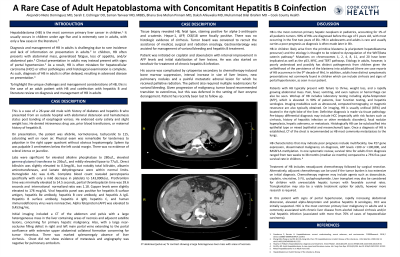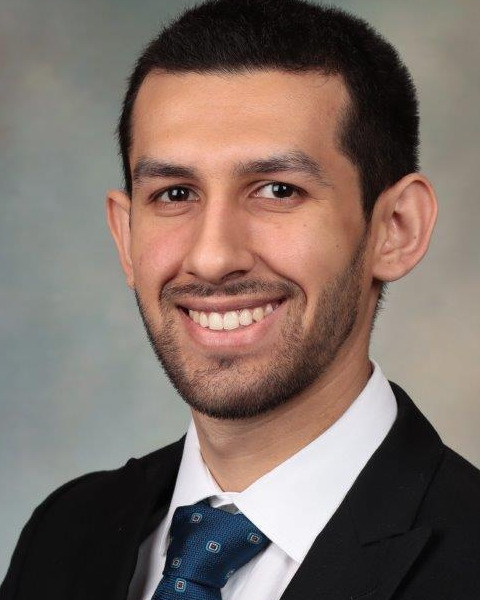Monday Poster Session
Category: Liver
P2544 - A Rare Case of Adult Hepatoblastoma With Concomitant Hepatitis B Coinfection
Monday, October 23, 2023
10:30 AM - 4:15 PM PT
Location: Exhibit Hall

Has Audio

Alejandro J. Nieto Dominguez, MD
Cook County Health and Hospital Systems
Chicago, Illinois
Presenting Author(s)
Award: Presidential Poster Award
Alejandro J.. Nieto Dominguez, MD1, Sarah Eichinger, DO2, Saman Tanveer, MD, MBBS2, Bhanu Siva Mohan Pinnam, MD2, Daksh Ahluwalia, MD2, Muhammad Bilal Ibrahim, MD2
1Cook County Health and Hospital Systems, Chicago, IL; 2John H. Stroger, Jr. Hospital of Cook County, Chicago, IL
Introduction: Hepatoblastoma (HB) is the most common primary liver cancer in children and is rare in adults, making diagnosis and management challenging. In children, HB presents with abdominal pain and fatigue whereas adults may present with portal hypertension. HB diagnosis in adults is often delayed with advanced disease on presentation. This is a rare case of an adult with HB and hepatitis B (HBV) coinfection.
Case Description/Methods: A 26-year-old male with diabetes and HBV presents with abdominal distension and hematemesis. He denied IV drug use, prior blood transfusion, or maternal history of HBV.
On presentation, physical exam was remarkable for right upper quadrant tenderness without hepatomegaly or jaundice. Labs revealed elevated ALK 280, GGT 236, and direct bilirubin 0.3. Total bilirubin, albumin, LFTs, and LDH were normal. CBC revealed pancytopenia (platelets 143,000). PT, PTT, and INR were mildly elevated. Hepatitis panel was positive for HBV sAG, HBV Be AB, HBV core Ab, and HAV IgG. AFP was 9,453.
CT abdomen pelvis showed a large heterogeneous liver mass with area of necrosis, large filling defect in the portal veins concerning for tumor thrombus, splenomegaly, and no cirrhosis. Tissue biopsy revealed HB. Tumor board was convened and patient was started tenofovir for HBV treatment and cisplatin and doxorubicin with improvement in AFP and stabilization of liver lesion.
Discussion: HB is the most common primary hepatic neoplasm in pediatrics, (1% of pediatric tumors). HB in adults has poor prognosis as diagnosis is often made late. HB in children likely arises from the primitive blastema but etiology of HB in adults is poorly understood, as it is unlikely that the blastema persists into adulthood.
Patients with HB present with failure to thrive and rapidly growing abdominal mass. Workup includes laboratory testing (AFP, LFTs, hepatitis) and imaging (US, CT, or MRI). HB is usually unifocal in the right liver lobe. Definitive diagnosis is made by tissue pathology. Treatment includes chemotherapy and surgical resection. Liver transplant may be considered with favorable survival rates in children, more research is required for viability in adults.
In this patient, differential included HCC given HBV, high AFP, and portal hypertension. HB diagnosis in adults is challenging given rarity of the disease and nonspecific symptoms. HB should remain on the differential for adults presenting with abdominal pain, cirrhosis and liver lesions so as to not delay diagnosis and improve prognosis.
Disclosures:
Alejandro J.. Nieto Dominguez, MD1, Sarah Eichinger, DO2, Saman Tanveer, MD, MBBS2, Bhanu Siva Mohan Pinnam, MD2, Daksh Ahluwalia, MD2, Muhammad Bilal Ibrahim, MD2. P2544 - A Rare Case of Adult Hepatoblastoma With Concomitant Hepatitis B Coinfection, ACG 2023 Annual Scientific Meeting Abstracts. Vancouver, BC, Canada: American College of Gastroenterology.
Alejandro J.. Nieto Dominguez, MD1, Sarah Eichinger, DO2, Saman Tanveer, MD, MBBS2, Bhanu Siva Mohan Pinnam, MD2, Daksh Ahluwalia, MD2, Muhammad Bilal Ibrahim, MD2
1Cook County Health and Hospital Systems, Chicago, IL; 2John H. Stroger, Jr. Hospital of Cook County, Chicago, IL
Introduction: Hepatoblastoma (HB) is the most common primary liver cancer in children and is rare in adults, making diagnosis and management challenging. In children, HB presents with abdominal pain and fatigue whereas adults may present with portal hypertension. HB diagnosis in adults is often delayed with advanced disease on presentation. This is a rare case of an adult with HB and hepatitis B (HBV) coinfection.
Case Description/Methods: A 26-year-old male with diabetes and HBV presents with abdominal distension and hematemesis. He denied IV drug use, prior blood transfusion, or maternal history of HBV.
On presentation, physical exam was remarkable for right upper quadrant tenderness without hepatomegaly or jaundice. Labs revealed elevated ALK 280, GGT 236, and direct bilirubin 0.3. Total bilirubin, albumin, LFTs, and LDH were normal. CBC revealed pancytopenia (platelets 143,000). PT, PTT, and INR were mildly elevated. Hepatitis panel was positive for HBV sAG, HBV Be AB, HBV core Ab, and HAV IgG. AFP was 9,453.
CT abdomen pelvis showed a large heterogeneous liver mass with area of necrosis, large filling defect in the portal veins concerning for tumor thrombus, splenomegaly, and no cirrhosis. Tissue biopsy revealed HB. Tumor board was convened and patient was started tenofovir for HBV treatment and cisplatin and doxorubicin with improvement in AFP and stabilization of liver lesion.
Discussion: HB is the most common primary hepatic neoplasm in pediatrics, (1% of pediatric tumors). HB in adults has poor prognosis as diagnosis is often made late. HB in children likely arises from the primitive blastema but etiology of HB in adults is poorly understood, as it is unlikely that the blastema persists into adulthood.
Patients with HB present with failure to thrive and rapidly growing abdominal mass. Workup includes laboratory testing (AFP, LFTs, hepatitis) and imaging (US, CT, or MRI). HB is usually unifocal in the right liver lobe. Definitive diagnosis is made by tissue pathology. Treatment includes chemotherapy and surgical resection. Liver transplant may be considered with favorable survival rates in children, more research is required for viability in adults.
In this patient, differential included HCC given HBV, high AFP, and portal hypertension. HB diagnosis in adults is challenging given rarity of the disease and nonspecific symptoms. HB should remain on the differential for adults presenting with abdominal pain, cirrhosis and liver lesions so as to not delay diagnosis and improve prognosis.
Disclosures:
Alejandro Nieto Dominguez indicated no relevant financial relationships.
Sarah Eichinger indicated no relevant financial relationships.
Saman Tanveer indicated no relevant financial relationships.
Bhanu Siva Mohan Pinnam indicated no relevant financial relationships.
Daksh Ahluwalia indicated no relevant financial relationships.
Muhammad Bilal Ibrahim indicated no relevant financial relationships.
Alejandro J.. Nieto Dominguez, MD1, Sarah Eichinger, DO2, Saman Tanveer, MD, MBBS2, Bhanu Siva Mohan Pinnam, MD2, Daksh Ahluwalia, MD2, Muhammad Bilal Ibrahim, MD2. P2544 - A Rare Case of Adult Hepatoblastoma With Concomitant Hepatitis B Coinfection, ACG 2023 Annual Scientific Meeting Abstracts. Vancouver, BC, Canada: American College of Gastroenterology.

